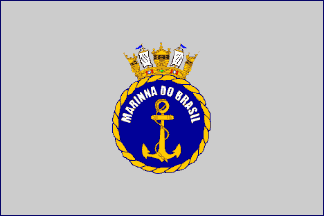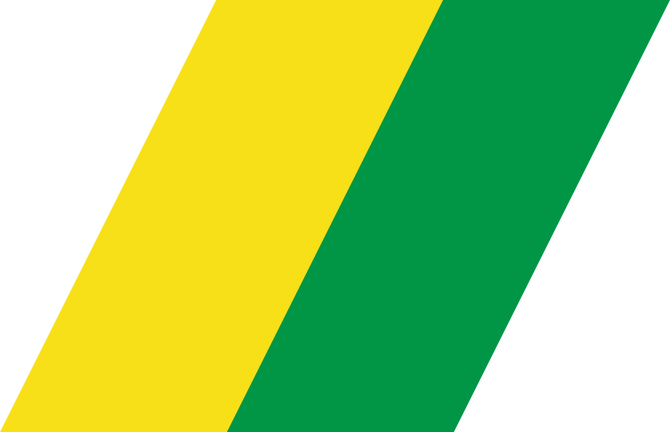![[Brazilian National Flag and Ensign]](../images/b/br1.gif) by Joseph McMillan
by Joseph McMillan
Last modified: 2025-11-08 by ian macdonald
Keywords: navy | cruzeiro | jack | pennant | commissioning pennant | warship pennant | standard | anchor |
stars: 21 (white) |
Links: FOTW homepage |
search |
disclaimer and copyright |
write us |
mirrors
The Brazilian Navy flies the regular national flag as its ensign.
I found a publication which describes and illustrates naval flags and ensign,
and rank flags of the Navy:
https://www.marinha.mil.br/eames/sites/www.marinha.mil.br.eames/files/CERIMONIAL.pdf
Zoltan Horvath, 2 October
2025
The Brazilian jack is known as the Cruzeiro flag: 21 white stars on a dark blue field - a horizontal
row of 13 and a vertical column of 9, orthogonally displayed (therefore
with one star in common, so that total is 13+9-1=21).
Ivan Sache, 1 July 1998
Proportions 3:4. The famous Brazilian Cruzeiro is of importance as it
is the basis for a whole
set of Brazilian naval flags. It seems to me that the number of stars is
maintained on 21 even if the number of the states has changed over the
years, and that sporadic reports of a different number are erroneous unless some
further evidence is shown. Those reports that agree with the number of stars as 21
seem to all agree in the their distribution--4 above and 4 below the central
star and 6 on each side.
Željko Heimer, 23 March 2001
Twenty-seven stars have been introduced by law of 11 May 1992 into the
national flag, but the jack goes on
unchanged, according to a letter dated 19 November 1992 from the Brazilian attaché in Paris.
Armand Noel du Payrat, 23 March 2001
I note that in the
Ceremonial code of the Brazilian Navy (MB Cerimonial) this flag is consistently referred
to as a Bandeira do Cruzeiro and not by whatever the generic
Portuguese word is for "jack." I even found a US Foreign Broadcast
Information Service lexicon of Portuguese military terminology at
that actually translates bandeira do cruzeiro as "jack."
Joseph McMillan, 23 March 2001
According to Clóvis Ribeiro, the
Cruzeiro flag was originally
adopted by decree 544 of 18 December 1847. The original version had 18 white
stars on an azul celeste field (although remember that azul celeste in Brazil
is often darker than the sky-blue color of the same name elsewhere). The stars
symbolized the 18 provinces of the empire at the time, while the cross
arrangement symbolized the original name given to Brazil by the early
Portuguese explorers, Santa Cruz, meaning "Holy Cross."
Additional stars were added in 1890 and 1900, so that by 1900 the flag had
20 stars, 10 vertically and 10 horizontally with a blank space at the center
of the cross.
Joseph McMillan, 20 October 2002
Ceremonial code of the Brazilian Navy (MB Cerimonial) Art. A-2 Bandeira do
Cruzeiro describes the jack:
"A Bandeira do Cruzeiro tem cor azul-marinho,
forma retangular, metade do número de panos da Bandeira Nacional que for
hasteada, dividida em quatro quadriláteros iguais por uma série de estrelas
brancas, uma posicionada no centro e as demais igualmente espaçadas entre si,
contando-se com a do centro treze no sentido do comprimento e nove no da largura,
totalizando 21 estrelas (Fig. 15)."
which translated means:
"Art A-2.
Cruzeiro Flag [Cruzeiro is short for "Cruzeiro do Sul," or "Southern Cross"] The
Cruzeiro flag is navy blue, rectangular in shape, half the size of the national
flag with which it is hoisted, divided into four equal quadrilaterals by a
series of white stars, one positioned in the center and the others equally
spaced from one another, with 13, counting the center one, in the direction of
the fly and nine [in the direction] of the hoist, totaling 21 stars (Fig. 15)."
Joseph McMillan, 4 May 2005
There are apparently no regulations with information regarding the size of
the stars, and that they are (presumably based on a photo of the flag in use)
smaller on the jack than on the command flags based upon it. Different artists
put the stars at 4 out of a hoist width of 90, or slightly larger 1/20 (3 out of
a hoist width of 60).
Christopher Southworth, 5 May 2005
Source: Album des Pavillons, 2000
Long triangular navy blue pennant with 21 stars in line, offset to the hoist.
Ratio is not indicated, but from the image in Album 2000 it appears to be
about 1:24. The
MB Cerimonial also pictures another pennant called "Command Pennant,"
which is of the same basic design but much shorter (about 1:7). What the functional
difference is between the two similar blue pennants I don't know.
Željko Heimer, 24 March 2001
MB Cerimonial is distinguishing between the masthead pennant at the
end of a commission (flâmula de fim de commisão) and the simple
commissioning pennant (flâmula de comando). The regulation spells
out that the former is used only on the ship's last voyage before
decommissioning. It is equivalent to the British "paying off pennant"
or the American "homeward bound pennant."
Joseph McMillan, 24 March 2001
The "General Ordinance for Brazilian Navy Flags," approved by Decree of 6 February 1942,
describes the "command pennant"
as having as many white stars as the states of Brazil, the stars covering half the length of
the pennant. The ordinance gives the dimensions
of command pennants
as 5 x 100 cm, 7 x 50 [sic; probably 150] cm, 13 x 300 cm, 17 x 400 cm, and 20 x 500 cm.
The distance between the stars equals 1/4 of the hoist at the head of the pennant.
The stars are sized to be circumscribed by an imaginary
circle occupying 2/3 of the width of the flag at the location of each star,
so that the stars diminish in size as they go from hoist to fly.
According to the ordinance, this pennant could be flown on a merchant ship commanded by a naval officer.
Joseph McMillan, , 22 April 2001
According to the law, article 2-3-3 (http://militar.com.br/legisl/imagemcdoerimonialdamarinha/cerimonialdamarinha.htm):
"The end of commission streamer is hoisted from the top of the main
mast in the ships attached to the
Brazilian Navy, replacing the command streamer, in the end of a commission
with length equal or larger than six months, when the ship begins the arrival
to the final port of the commission, and is removed at the following sunset."
Jorge Candeias, 26 June 2008
 image
by Zoltan Horvath, 2 October 2025
image
by Zoltan Horvath, 2 October 2025
The parade standard of the Brazilian Navy, mentioned but not described in
the Navy Ceremonial Manual,
is silver with the Navy badge on the
center, a navy blue roundel with an upright anchor and the name of the
service in gold, all surrounded by a gold rope and ensigned with a naval
crown. The flag is edged all around with dark blue cord. A blue and white
cockade and streamers, inscribed with the name of the service, are attached
below the spearhead finial. The staff is painted blue with a silver spiral
stripe.
Source: Photograph in the book, Fuzileiros Navais: Brazil's Amphibious
Warriors (Rio de Janeiro, 1997).
Joseph McMillan, 11 March 2003
An image of the flag shows in practice it is white:
https://antigo.visitebrasilia.com.br
Zoltan Horvath, 2 October
2025
Source: Album des Pavillons, 2000
Concentric rings of green, yellow, and navy blue. The note to the figure in Album 2000
explains that a white anchor is painted near the roundel, and that the fin flash of
green and yellow vertical bars
is sometimes fimbriated with blue.
Željko Heimer, 25 March 2001
 image by Zoltan Horvath, 2 October
2025
image by Zoltan Horvath, 2 October
2025
The Navy Port Authority racing stripe consists of yellow and green diagonal
stripes.
Images:
https://www.dreamstime.com/brazilian-guard-coast-boats
https://www.shutterstock.com/hu/image-photo/speedboat
Zoltan Horvath, 2 October 2025